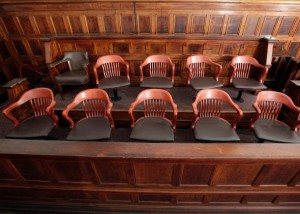Collateral Estoppel In Criminal Trials And The Advocate Witness Rule
People v Ortiz
2015 NY Slip Op 09233
New York Court of Appeals
Decided on: December 16 2015
Issue: Whether the doctrine of collateral estoppel bars the People from introducing at defendant’s second trial, evidence that defendant used a razor blade when the jury had acquitted him of those charges at the first trial and whether the advocate- witness rule applies when defense counsel made statements damaging to her client and must now withdraw from representation.
Holding: The Court of Appeals held that the doctrine of collateral estoppel originated in civil litigation as a means of ensuring the swift and peaceful resolu tion of disputes, People v Goodman, 69 NY2d 32, 37 [1986]. It applies in criminal prosecutions to bar relitigation of issues resolved in a defendant’s favor at an earlier trial, People v Acevedo, 69 NY2d 478, 484 [1987]. Here, the jury in the first trial decided that defendant did not use a razor blade by acquitting him of first-degree burglary; requiring that the People prove that defendant used or threatened the use of a dangerous instrument, Penal Law 140.30.
tion of disputes, People v Goodman, 69 NY2d 32, 37 [1986]. It applies in criminal prosecutions to bar relitigation of issues resolved in a defendant’s favor at an earlier trial, People v Acevedo, 69 NY2d 478, 484 [1987]. Here, the jury in the first trial decided that defendant did not use a razor blade by acquitting him of first-degree burglary; requiring that the People prove that defendant used or threatened the use of a dangerous instrument, Penal Law 140.30.
Pursuant to the advocate-witness rule, a lawyer must withdraw from representation when it becomes apparent that she must testify on behalf of her own client (former Code of Professional Responsibility DR 5-102[a] [22 NYCRR 1200.21(a); Rules of Professional Conduct [22 NYCRR 1200.0] rule 3.7[a]; see also People v Berroa, 99 NY2d 134, 140 [2002]. An attorney should not continue to serve as an advocate when it is obvious that the lawyer will be called as a witness on behalf of the client. The rule seeks to avoid the unseemly circumstance of placing an attorney in a position in which he must argue the credibility of his own testimony, Ellis v Broome Cnty, 183 AD2d 861, 862 [3d Dept 1984], which may confuse the fact-finder and impair the fairness of the trial, People v Townsley, 20 NY3d 294, 299 [2012]
Here, defense stated that she misspoke at arraignment and that introducing the statement would force her to become a witness and that her clients right to confront her about the statement would require her to take the stand and tell the jury that she misstated material facts moments before advocating for her clients innocence in summation. Defense counsel had no choice but to withdraw and in these unusual circumstances, the Court of Appeals held that the trial court should have granted counsels request to withdraw or declared a mistrial.
Facts: Defendant Luis Ortiz was charged with burglary in the first degree (Penal Law 140.30[3], burglary in the second degree (Penal Law 140.25) According to the People, Colpo Manuel Valenzuela was entering his apartment with his girlfriend Para Nunez when defendant approached them from behind, grabbed Nunez and, while holding a razor blade to her neck, pushed them both through the door. Defendant threatened to cut Nunezs throat if Valenzuela did not give him money or jewelry. Valenzuela struck defendant in the head and restrained defendant in the bedroom.
 At trial, Defendant testified that he and a female friend went to the apartment building looking for a room to rent and stopped at Valenzuelas apartment to ask for the superintendent. Valenzuela made inappropriate comments to defendants friend and the two men engaged in a verbal altercation that escalated to the fight. At some point during the fight, Valenzuela pulled defendant into the apartment. He testified that he was unarmed but that Valenzuela grabbed a kitchen knife, eventually restraining him on the bed. The jury rejected defendants rendition of events and found him guilty of burglary in the second degree. The Appellate Division reversed the conviction for reasons not relevant to this appeal (69 AD3d 490 [1st Dept 2010], and defendant proceeded to a second trial on the charge of burglary in the second degree.
At trial, Defendant testified that he and a female friend went to the apartment building looking for a room to rent and stopped at Valenzuelas apartment to ask for the superintendent. Valenzuela made inappropriate comments to defendants friend and the two men engaged in a verbal altercation that escalated to the fight. At some point during the fight, Valenzuela pulled defendant into the apartment. He testified that he was unarmed but that Valenzuela grabbed a kitchen knife, eventually restraining him on the bed. The jury rejected defendants rendition of events and found him guilty of burglary in the second degree. The Appellate Division reversed the conviction for reasons not relevant to this appeal (69 AD3d 490 [1st Dept 2010], and defendant proceeded to a second trial on the charge of burglary in the second degree.
Defense counsel moved to preclude the prosecution from presenting evidence of the razor blade at trial, arguing that the jury in the first trial necessarily decided that defendant did not use a razor blade by acquitting him of first-degree burglary; requiring that the People prove that defendant used or threatened the use of a dangerous instrument, Penal Law 140.30. The trial court denied the motion and allowed the Peoples witnesses to testify about the use of the razor blade.
On cross-examination, the People attempted to impeach defendants testimony that Valenzuela came after him with a kitchen knife with the following statement made by his counsel:
Your Honor, my understanding of the events for defendant is vastly different from the prosecutions. I believe defendant was at this apartment looking to possibly rent a room there. An argument began between him and the landlord, and at which point the complaining witness came after him with a razor blade, which explains why it was recovered, and that it belongs to the people who lived there.
The People sought to introduce this statement to show that defendant previously told his attorney that Valenzuela came after him with a razor blade, not a kitchen knife, as he testified. Defense counsel objected, arguing that she misspoke at arraignment and that introducing the statement would force her to become a witness. The court overruled defendants objection and allowed the prosecution to impeach defendant with counsels prior statement. She then asked to withdraw as counsel and moved for a mistrial, arguing that her clients right to confront her about the statement would require her to take the stand and tell the jury that she misstated material facts moments before advocating for her clients innocence in summation. The court denied counsels request but offered to have another attorney question her about the statement or to introduce a stipulation as to what counsel would say if asked about the statement.
After renewing her objection and being overruled a second time, she agreed to the stipulation, which the court read aloud to the jury. It provided that if counsel were to testify, she would state that her remarks at arraignment were incorrect and that defendant did not tell her Valenzuela came after him with a kitchen knife. The jury convicted defendant of burglary in the second degree.
Defendant moved to set aside the conviction pursuant to CPL 330.30(1) on the grounds that the trial court erred in not precluding testimony about the razor blade and in denying defense counsels motion to withdraw. Supreme Court denied the motion and sentenced defendant as a persistent felony offender. The Appellate Division modified the judgment by vacating the sentence and remanding the case for resentencing, and affirmed. A judge of the Court of Appeals granted leave to Appeal and the Court reversed.
Legal Analysis:
Collateral Estoppel
The Court of Appeals held that the doctrine of collateral estoppel originated in civil litigation as a means of ensuring the swift and peaceful resolution of disputes, People v Goodman, 69 NY2d 32, 37 [1986]. It applies in criminal prosecutions to bar relitigation of issues resolved in a defendants favor at an earlier trial, People v Acevedo, 69 NY2d 478, 484 [1987]. The Court has considered the doctrine most recently in People v OToole, 23 NY3d 335 [2013] where they held that defendants acquittal of first degree robbery based on the alleged display of a firearm barred the People from introducing, at a later trial for second-degree robbery, evidence that a firearm was displayed.
The Court of Appeals also held that the rigid application of collateral estoppel sometimes gives way to societys interest in ensuring the correctness of criminal prosecutions, People v Berkowitz, 50 NY2d 333, 345 [1980]. If it becomes apparent, in a future case, that collateral estoppel cannot be practicably followed if a necessary witness is to give truthful testimony, then the doctrine should not be applied, OToole, 22 NY3d at 339. Collateral estoppel did not pose practical difficulties in OToole because the facts could be told in such a way, on retrial, that they do not call for testimony about the firearm: the second-degree robbery charge required the People to prove only that defendant forcibly stole property aided by another person actually present. Without mentioning the firearm, Horsey could have testified that a large man came into the shop, handed him a phone with defendant on the other end and led horsey outside to meet defendant who ultimately stole Horseys gold chain. The version of events would not have required the complaining witness to materially alter his testimony or provide the jury with a misleading or untruthful account.
By contrast, the practical difficulties of applying collateral estoppel in this case outweigh the otherwise sound reasons for preventing repetitive litigation, Berkowitz, 50 NY2d at 344. Unlike the witness in OToole, Nunez and Valenzuela would have had to materially alter their testimony and mislead the jury in order to omit reference of the razor blade. They both testified that defendant threatened to cut Nunezs throat because Valenzuela did not give him money or jewelry and that defendant made a slitting gesture with his hand when he uttered the threat. If not permitted to mention the razor blade, the complainants would have been required to eliminate this portion of their testimony or else state, misleadingly, that defendant pushed Nunez and Valenzuela into the apartment and threatened her or what he threatened to do. Nunez also would have been prevented from explaining why she put up no resistance to a man she had never seen before. The fact that Nunez did not tell the 911 operator about the razor blade does not mean she could omit it from her testimony in court.
The material changes that these key witnesses would have had to make to their testimony in order to recount the incident without reference to the razor blade present the kind of unreasonable difficulty that, the Court of Appeals has warned in OToole, jeopardizes the jurys truth seeking function and outweighs the need for collateral estoppel. Therefore even if the jury necessarily decided that defendant did not use or threaten the use the razor blade, the Appellate Division correctly determined the doctrine doesnt apply.
———————————————————————————————————————————————-
Advocate-Witness Rule
The second issue in this appeal concerns the advocate-witness rule. Pursuant to that rule, a lawyer must withdraw from representation when it becomes apparent that she must testify on behalf of her own client (former Code of Professional Responsibility DR 5-102[a] [22 NYCRR 1200.21(a); Rules of Professional Conduct [22 NYCRR 1200.0] rule 3.7[a]; see also People v Berroa, 99 NY2d 134, 140 [2002]. An attorney should not continue to serve as an advocate when it is obvious that the lawyer will be called as a witness on behalf of the client. The rule seeks to avoid the unseemly circumstance of placing an attorney in a position in which he must argue the credibility of his own testimony, Ellis v Broome Cnty, 183 AD2d 861, 862 [3d Dept 1984], which may confuse the fact-finder and impair the fairness of the trial, People v Townsley, 20 NY3d 294, 299 [2012].
In Berroa, The Court held that a stipulation by defense counsel violated the advocate-witness rule and deprived defendant of his right to conflict-free counsel where the stipulation transformed the defendants advocate into an adverse witness and pitted counsels credibility against other witnesses (99 NY2d at 138). Defendants trial counsel in Berroa was the only person who could impeach two key witnessed whose testimony deviated in substantial part from information they had provided to counsel before trial. Although the parties agreed to a stipulation in lieu of having counsel testify, the Court held that the stipulation exacerbated counsels conflict by eviscerating the credibility of her clients witnesses and his defense. (id. at 139). Similarly in this case, the defendants counsel was placed in an untenable position when the People introduced counsels statement from arraignment.
Anyone familiar with arraignment practices in New York criminal courts understands the hurried nature of those proceedings and the likelihood, as occurred here, that defense counsel may appear on behalf of 30 defendants in one night. It is no surprise then that she mistakenly stated that defendant told her Valenzuela came after him with a razor blade instead of a knife. The prosecutor sought to use this statement to attack defendants credibility, and in doing so, caused defendants advocate to become his adversary. Indeed, the one person in the courtroom whose job was to advocate for it attacked defendants credibility.
The situation went from bad to worse when it became clear that the only way for defense counsel to rehabilitate her clients responsibility was the impugn her own, moments before she would argue for her clients innocence in summation. Defense counsel had no choice but to withdraw and in these unusual circumstances, the Court of Appeals held that the trial court should have granted counsels request to withdraw or declared a mistrial. Accordingly the Appellate Division should be reversed and a new trial ordered.
